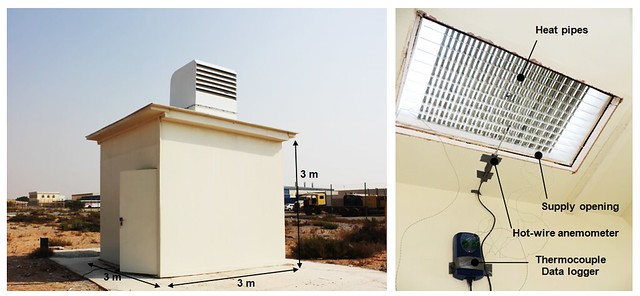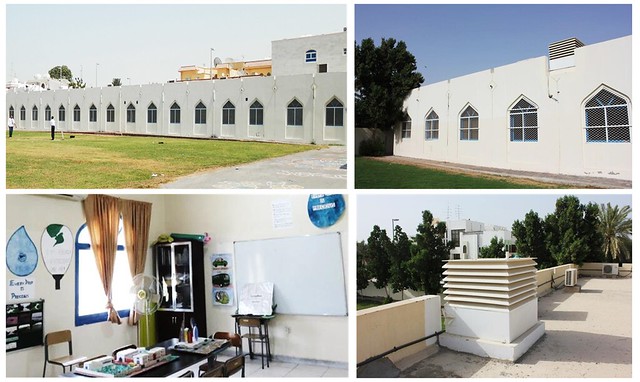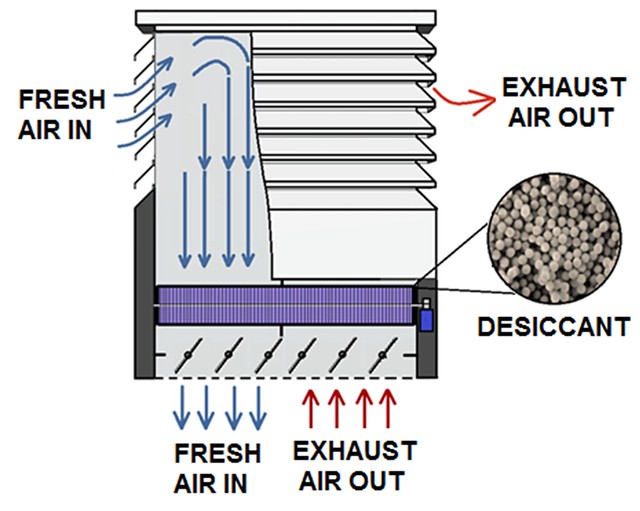Contact
Biography
He is a Chartered Engineer (CEng) and Member of the Institution of Mechanical Engineers (MIMechE). He received his Mechanical Engineering (Class I) honours degree from Heriot-Watt University in 2010 and his PhD from the University of Leeds in 2013. He has held full time research and academic positions in UK Russell Group institutions namely the University of Nottingham, University of Leeds and the University of Sheffield. Research output includes peer-reviewed journal publications in Applied Energy, Architectural Science Review, Building and Environment, Energy in Buildings, Journal of Wind Engineering & Industrial Aerodynamics and Renewable & Sustainable Energy Reviews.
During his PhD, He has designed, built and tested innovative passive cooling technologies taking his work from desktop design through laboratory scale testing and on to full-scale installations. He along with his team have recently filed UK patent applications for a zero energy passive cooling device (WO2015/087035) and humidity control system (GB1506768.9). 
Dr Calautit has expertise in design and simulation modelling of new and existing buildings both in public and private sector. He has provided design and consultancy for sustainable solutions in buildings in the private and public sector in the UK and Europe including BMW, British Gas, Cynergin, Kent City Council, AMRC, University of London.
Over the past 4 years, he has published 120 peer-reviewed journal papers, conference papers, book chapters, patents and editorials. His H-index is 16 with 846 citations.
He is the Vice-Chair and Editor of Engineering Sustainability of the Institution of Civil Engineers (ICE), Editor-in-chief of Sustainable Buildings in EDPScience and Associate Editor of Innovative Infrastructure Solutions in Springer. He also serves on the scientific committees of international conferences including Sustainability in Energy and Buildings and Zero Energy Mass Custom Home. Recently, he edited the Special Issue on "Sustainability and energy in buildings - part 1 and part 2" which explored emerging research topics in the areas of energy and buildings, including big data, renewable energy integration, energy performance gap, advanced materials and technologies in building construction, hybrid energy systems and smart cities.
He has supervised 17 MEng/MSc students (15 completed) and is currently supervising 6 PhD students (2 completed).
He has led and worked on research projects funded by the Qatar National Research Fund (NPRP6-461-2-188), Newton-DOST Fund (no. 209559487), British Council-CHED Fund, EPSRC (CASE Award, IAA, Enterprise Fund) and Grantham Foundation Fund (no. 315502).




He is also part of the Buildings, Energy and Environment Research Group.
Expertise Summary
Dr Calautit has designed, built and tested innovative passive cooling technologies taking his work from desktop design through laboratory scale testing and on to full-scale installation. Dr Calautit has expertise in design and simulation modelling of new and existing buildings both in public and private sector. Dr Calautit has developed passive cooling technologies for the Middle East market and continues to develop thermal comfort strategies for large infrastructure providers in the region.

Other research interest lies in thermal comfort, indoor air quality (IAQ), natural ventilation, renewable energy technologies, building engineering, urban physics, wind engineering, design optimisation, Computational Fluid Dynamics (CFD), Building Energy Simulation and wind tunnel testing.
COMPUTATIONAL FLUID DYNAMICS MODELLING
Building scale modelling


Urban scale modelling


BUILDING ENERGY MODELLING


RAPID PROTOTYPING


WIND TUNNEL TESTING



FIELD TESTING


Teaching Summary
Current modules:
1st Year BEng - K11AE1 Architectural Engineering Design 1
1st Year BEng - K11AE2 Architectural Engineering Design 2
2nd Year BEng - K12EPM Environmental Performance Modelling
2nd Year MEng - K12SAD Simulation and Design
2nd Year BEng - K12AE4 Architectural Engineering Design 4
3rd Year BEng - K13AE5 Architectural Engineering Design 5
3rd Year MEng - K14ASD Advanced Study Dissertation
Previous modules:
3rd Year BEng/MEng - Building Energy Simulation (MEC345)
3rd Year BEng/MEng - Application of CFD in Building Engineering/Physics (CIVE5810M)
3rd Year BEng/MEng - Building Thermal Modelling using Autodesk ECOTECT (CIVE5709M)
MEng Mechanical Engineering Dissertation supervision (MEC401)
MEng Architectural Engineering Dissertation supervision (CIVE5708M)
Previous Laboratories:
Closed-loop subsonic wind tunnel simulations (CIVE2815/CIVE3815)
3D rapid prototyping (CIVE2815/CIVE3815)
Building Physics laboratories: airflow, daylighting, acoustics (CIVE2815/CIVE3815 )
Application of CFD in Building Engineering/Physics (CIVE5810M)
Research Summary
British Council, CHED-Newton Fund, Artificial Neural Network Modelling of Air Pollution in Philippines, 2016-2019, £120,000, PI
Innovate UK 4th Round Energy Catalyst, Late Stage Development Award, Free Running Buildings and University of Sheffield, £400,000, Co-I
British Council, DOST-Newton Fund, Energy Efficiency and Effectiveness of the Windbelt Technology of Urban Installation in the Philippines, 2016-2019, £114,020, PI
EPSRC DTG and BMW Group, Postgraduate Research Project, 2016-2019, Integrated-Energy Modelling for Energy Efficiency and Sustainability in the Automotive Sector, £76,827. Co-I
Grantham Centre for Sustainable Futures, Grantham Scholar Research Project, 2016-2020, Development of a low-cost, portable and solar-powered pump for improving income, food and energy security in developing countries, £158,848. Co-I
Innovation, Impact and Knowledge Exchange (IIKE), Collaborative R&D Awards, 2016 -2017, Mapping Factory End User Energy Consumption, £50,000. Co-I
Enterprise fund - Grub fund investment for Free Running Buildings Ltd (University of Leeds and the IP Group). 2013-14, £72,000, Co-PI
Qatar National Research Fund 6th Cycle, Thermal Comfort of Spectators and Players in Qatari Stadiums, NPRP 6-461-2-188, £750,000, Named Researcher
Qatar National Research Fund 3rd Cycle, Integration of Passive Ventilation and Novel Cooling Systems for Reducing Air Conditioning Loads in Buildings, NPRP 09-138-2-059, £700,000, Named Researcher
PhD students (2 completed, 4 on-going)
Dr Dominic O'Connor - Completed, current Research Associate, Uni. of Sheffield
Start date: August 2013
Project: Integrating heat recovery into natural ventilation for energy conservation
Ms Polytimi Sofotasiou - Completed
Start date: July 2013
Project: Aerothermal comfort conditions in sports arenas in hot- humid climates
Ms Siti Diana Nasir - 3rd Year Ph.D Student
Start date: December 2013
Project: Influence of urban canyon on the performance of pavement solar collector
Mr Angelo Aquino - 1st Year DOST-Newton Fund Scholar (UK-Philippine partnership)
Start date: January 2016
Project: Energy Efficiency and Effectiveness of the Windbelt Technology of Urban Installation in the Philippines
Mr Mohammad Alobaid - 1st Year Ph.D Student
Start date: January 2015
Project: Optimisation of solar-thermal technologies for the built environment
Mr Sheen Cabaneros - 1st Year CHED-Newton Fund Scholar (UK-Philippine partnership)
Start date: January 2017
Project: Artificial Neural Network Modelling of Air Pollution in Philippines
MEng/MSc Student Supervision (15 completed, 1 on-going)
For Building Energy Simulation and Computational Fluid Dynamics (CFD) projects/consultancy, contact John.Calautit1@nottingham.ac.uk
Advanced Manufacturing Research Centre (AMRC) - Building energy simulation (BES) and analysis of theFactory 2050

BMW Plant Munich, Germany - Building energy simulation (BES) and analysis of the assembly plant of BMW in Munich and energy efficiency strategies

Sayes & Co Ltd, UK - Building energy simulation (BES) and indoor air quality analysis of the Aidan's Primary School in Ilford, UK. Assess current natural ventilation strategies based on BB101 in teaching spaces.

Woodmansterne Primary School - Building energy simulation (BES) of the ventilation system of the Woodmansterne Primary School in Banstead, UK.

Dolphin, AbuDhabi - Building energy simulation (BES) analysis of the integration of passive cooling into the workshops and equipment store of a proposed facility
Shaikh Khalifa School, Abu Dhabi - Thermal comfort and building energy modelling (BEM) of a school in Abu Dhabi. Installation of windcatcher.

Kent City Council, UK - Building energy modelling (BEM) of the Dover Discovery Centre using Autodesk Ecotect analysis tools.

British Gas, UK - Building energy modelling (BEM) modelling of the EPSOM Building using Autodesk Ecotect analysis tools.

University of London and Cynergin, UK - Building energy modelling (BEM) of office spaces in Institute Advance Legal Studies (IALS) building using Autodesk Ecotect analysis tools.

Cynergin, UK - Building energy modelling (BEM) of office spaces in University of College London using sustainable energy analysis tools.

University of Leeds, UK - Building energy modelling (BEM) of new teaching space in the School of Civil Engineering.

Sheffield Hallam University, UK - Computational Fluid Dynamics (CFD) modelling of a hand-held device for respiratory rate measurement.
Nakheel, UAE - Computational Fluid Dynamics (CFD) modelling of a residential building with wind towers.
Midtherm Engineering, UK - Computational Fluid Dynamics (CFD) modelling of a circular shape wind tower device.
Past Research
Integration of Passive Ventilation and Novel Cooling Systems for Reducing Air Conditioning Loads in Buildings, Qatar National Research Fund 3rd Cycle, NPRP 09-138-2-059, $1,050,000, Named Researcher
This research focused on the development of a passive cooling wind tower with heat pipe material for the reduction of energy in built environment. I've utilised different methodologies such as Computational Fluid Dynamics (CFD) modelling, Building Energy Modelling (BEM) and wind tunnel experimental methods to develop and investigate a novel prototype. I've tested and patented the technology (WO2015/087035) during the final stages of my doctorate.

Prototype development and field tests of passive cooling wind towers, University of Leeds and the IP Group, £36,000, Co-I

Design and specification of natural ventilation for Shaikh Khalifa Bin Zayed Bangladeshi Islamia School. Zayed Future Energy Prize, June 2014, £5,000, co-PI
A multi-directional type cooling wind tower was installed in a school building in the Middle East to conduct post occupancy evaluation. This research project was supported by the Zayed Future Energy Prize.

Development of a passive dehumidification technology, EPSRC Impact Acceleration Account, £36,000, Co-I
Rotary desiccant wheels are used to regulate the relative humidity of airstreams. These are commonly integrated into Heating, Ventilation and Air-Conditioning units to reduce the relative humidity of incoming ventilation air. To maximise the surface area, desiccant materials are arranged in a honeycomb matrix structure which results in a high pressure drop across the device requiring fans and blowers to provide adequate ventilation. This restricts the use of rotary desiccant wheels to mechanical ventilation systems. Passive ventilation systems are able to deliver adequate ventilation air but cannot control the humidity of the incoming air. To overcome this, the traditional honeycomb matrix structure of rotary desiccant wheels was redesigned to maintain a pressure drop value below 2 Pa, which is required for passive ventilation purposes. In addition to this, the temperature of the regeneration air for desorption was lowered. Radial blades extending out from the centre of a wheel to the circumference were coated in silica gel particles to form a rotary desiccant wheel (Patent GB1506768.9).

Thermal Comfort of Spectators and Players in Qatari Stadiums, Qatar National Research Fund 6th Cycle, NPRP 6-461-2-188, $1,048,000, Named Researcher
This research focused on the development of low-energy cooling strategies for the upcoming 2022 FIFA World Cup for reducing the energy consumption whilst maintaining thermal comfort. The overall aim of the project was to advance knowledge in the area of cost effective thermal comfort in stadiums and sporting arenas using cutting edge computational simulation, wind tunnel tests and field experiments to optimise performance of existing and emerging low energy building services technologies to minimise the energy consumption impact of new Qatari stadiums. Hence, emitting less CO2 to the atmosphere to conserve energy resources, preserve the local environment, meet the country's FIFA obligation and improve the quality of life.

Future Research
I welcome enquiries from potential PhD candidates from Home, EU and international countries who are interested in the following research areas: design and simulation modelling, sustainable solutions in buildings in the private and public sector, innovative passive cooling technologies, laboratory scale testing, full-scale installation, indoor air quality (IAQ), renewable energy technologies, urban physics, Computational Fluid Dynamics (CFD), Building Energy Simulation and wind tunnel testing, passive cooling wind tower, reduction of energy in built environment, Building Energy Modelling (BEM), Neural networks, Artificial intelligence, Machine learning, Deep learning, Thermal comfort, Desalination, Thermochemical energy storage, Typhoon resilience, Heat island effect
Low-energy Harvesting for Smarter Cities (2016-present)

In this modern age low-energy devices are pervasive especially when considering their applications in the built-environment. The multitude of low-energy applications extend from wireless sensors, radio-frequency transceivers, charging devices, cameras and other small-scale electronic devices. The energy consumptions of these devices range in the milliwatt and microwatt scale which is a result of continuous development of these technologies. Thus, renewable wind energy harnessed from the aeroelastic, triboelectric and peizoelectic effect can play a pivotal role in providing sufficient power for extended operation with little or no battery replacement.
Key publications:
[1] ANGELO AQUINO, JOHN KAISER CALAUTIT and BEN RICHARD HUGHES, 2017. Integration of aero-elastic belt into the built environment for low-energy wind harnessing: Current status and a case study Energy Conversion and Management. In Press
[2] ANGELO AQUINO, JOHN KAISER CALAUTIT and BEN RICHARD HUGHES, 2017. Urban Integration of Aeroelastic Belt for Low-Energy Wind Harvesting Energy Procedia. 105, 738-743
Urban Integrated Solar Pavements (2015-present)

Pavements tend to absorb the heat of the sun up to the point when they radiate heat as quickly as they are absorbing it: the surface temperature of pavements in direct sunlight can often reach up to 15°C higher than the ambient air temperature. Solar pavements heat using fluid circulating through an array of pipes embedded in the surface of the road and deposits it in storage constructed beneath the insulated foundation of buildings. This project investigates the performance of an urban-integrated solar pavement system by using numerical simulations.
Key publications:
[1] DIANA S. N. M. NASIR, BEN RICHARD HUGHES and JOHN KAISER CALAUTIT, 2017A CFD analysis of several design parameters of a road pavement solar collector (RPSC) for urban application Applied Energy. 186, 436-449
[2] DIANA S. N. M. NASIR, BEN RICHARD HUGHES and JOHN KAISER CALAUTIT, 2017. Influence of urban form on the performance of road pavement solar collector system: Symmetrical and asymmetrical heights Energy Conversion and Management. In Press
[3] DIANA S. N. M. NASIR, BEN RICHARD HUGHES, JOHN KAISER CALAUTIT, ANGELO AQUINO and SALLY SHAHZAD, 2017. Effect of Urban Street Canyon Aspect Ratio on Thermal Performance of Road Pavement Solar Collectors (RPSC) Energy Procedia. 105, 4414-4419
[4] DIANA S. N. M. NASIR, BEN RICHARD HUGHES and JOHN KAISER CALAUTIT, 2015. A study of the impact of building geometry on the thermal performance of road pavement solar collectors ENERGY. 93, 2614-2630
Advance Personal Comfort System in Offices (2016-present)

This project aims to improve user comfort and satisfaction regarding the thermal environment in the open plan office, which is a current challenge in the workplace addressed by limited research. The main difficulty in an open plan setting is that changing the room temperature in an area affects all occupants seated nearby. This issue in addition to individual differences in perceiving the thermal environment create a great challenge to satisfy all occupants in the workplace. This study investigates the application of an advanced thermal system, which allows individual control over their immediate thermal environment without affecting the thermal environment and comfort of other occupants.
Key publications:
[1] SALLY S. SHAHZAD, JOHN KAISER CALAUTIT, ANGELO AQUINO, DIANA S. N. M. NASIR and BEN RICHARD HUGHES, 2017. A user-controlled thermal chair for an open plan workplace: CFD and field studies of thermal comfort performance Applied Energy. In Press
[2] SALLY SHAHZAD, BEN RICHARD HUGHES, JOHN KAISER CALAUTIT and DIANA S. N. M. NASIR, 2017. Computational and Field Test Analysis of Thermal Comfort Performance of User-controlled Thermal Chair in an Open Plan Office Energy Procedia. 105, 2635-2640
[3] SHAHZAD, SALLY, BRENNAN, JOHN, THEODOSSOPOULOS, DIMITRIS, HUGHES, BEN and CALAUTIT, JOHN KAISER, 2017. Energy and comfort in contemporary open plan and traditional personal offices APPLIED ENERGY. 185, 1542-1555
[4] SHAHZAD, SALLY, BRENNAN, JOHN, THEODOSSOPOULOS, DIMITRIS, HUGHES, BEN and CALAUTIT, JOHN KAISER, 2017. A study of the impact of individual thermal control on user comfort in the workplace: Norwegian cellular vs. British open plan offices ARCHITECTURAL SCIENCE REVIEW. 60(1), 49-61
[5] SHAHZAD, SALLY S., BRENNAN, JOHN, THEODOSSOPOULOS, DIMITRIS, HUGHES, BEN and CALAUTIT, JOHN KAISER, 2016. Building-Related Symptoms, Energy, and Thermal Control in the Workplace: Personal and Open Plan Offices Sustainability. 8(4)